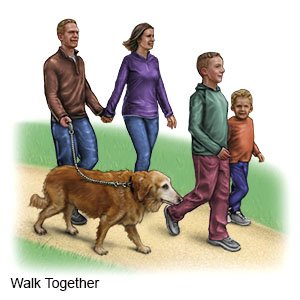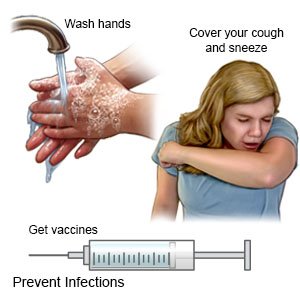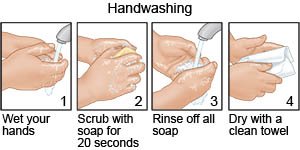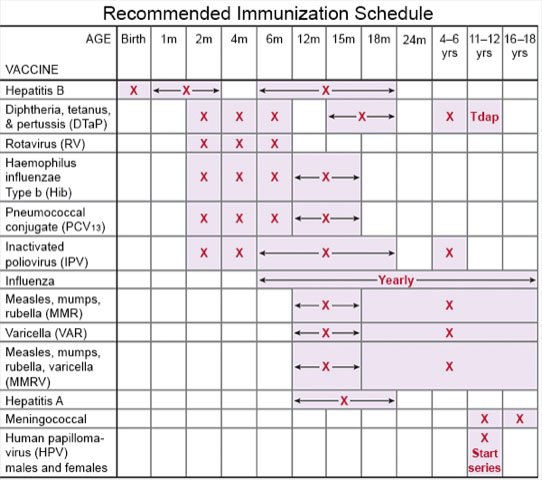Bronchiectasis in Children
Medically reviewed by Drugs.com. Last updated on Nov 3, 2024.
Bronchiectasis is a condition that causes mucus to collect in your child's airway. Chronic respiratory infections or inflammation cause the bronchi to become thick. Bronchi are larger airways that help carry air in and out of your child's lungs. The lungs make mucus to trap and remove germs and irritants that your child breathes. Bronchiectasis prevents your child's lungs from clearing the mucus. This leads to more infections and inflammation, and scarring in the lungs.
 |
DISCHARGE INSTRUCTIONS:
Call your local emergency number (911 in the US) if:
- Your child has sudden or more severe trouble breathing.
- Your child has severe chest pain.
Call your child's doctor or pulmonologist if:
- Your child coughs up blood.
- Your child is confused or feels faint.
- Your child has a fever.
- Your child coughs more than usual or wheezes.
- Your child's medicines do not relieve his or her symptoms.
- You have questions or concerns about your child's condition or care.
Medicines:
Your child may need any of the following:
- Antibiotics help fight or prevent an infection caused by bacteria.
- Bronchodilators help open the air passages in your child's lungs.
- Expectorants help thin your child's mucus. Thin mucus may be easier to cough up.
- Steroids help decrease inflammation in your child's lungs and open his or her airway so he or she can breathe easier.
- Give your child's medicine as directed. Contact your child's healthcare provider if you think the medicine is not working as expected. Tell the provider if your child is allergic to any medicine. Keep a current list of the medicines, vitamins, and herbs your child takes. Include the amounts, and when, how, and why they are taken. Bring the list or the medicines in their containers to follow-up visits. Carry your child's medicine list with you in case of an emergency.
Manage your child's bronchiectasis:
- Take your child to pulmonary rehabilitation (rehab) as directed. Pulmonary rehab is a program that can help your child learn how to manage bronchiectasis and prevent exacerbations. The plan will include aerobic exercise, such as walking, swimming, or riding a bicycle. Regular exercise helps your child's lungs work well and helps keep the airway clear. Rehab can help your child increase his or her ability to exercise for as long as recommended. Your child's plan will change over time as he or she starts to become responsible for his or her own care.

- Help your child keep his or her airway clear and open. Have your child do airway clearance techniques as needed. Healthcare providers will show your child how to do these in pulmonary rehab. A saline nasal rinse can help clear irritants from your child's sinuses. Your child can help thin mucus by drinking more liquids or using a cool mist humidifier.
- Help your child avoid cigarette smoke. Nicotine and other chemicals in cigarettes and cigars can cause lung damage and make his or her symptoms worse. Do not smoke around your child or allow others to smoke around him or her. Do not let your adolescent smoke. Ask your healthcare provider for information if he or she currently smokes and needs help to quit. E-cigarettes or smokeless tobacco still contain nicotine. Talk to your healthcare provider before your adolescent uses these products.
Treatment options
The following list of medications are related to or used in the treatment of this condition.
Prevent the spread of germs:
 |
- Have your child wash his or her hands often. He or she should wash after using the bathroom and before preparing or eating food. Have your child use soap and water. Show him or her how to rub soapy hands together, lacing the fingers. Wash the front and back of the hands, and in between the fingers. The fingers of one hand can scrub under the fingernails of the other hand. Teach your child to wash for at least 20 seconds. Use a timer, or sing a song that is at least 20 seconds. An example is the happy birthday song 2 times. Have your child rinse with warm, running water for several seconds. Then dry with a clean towel or paper towel. Your older child can use hand sanitizer that contains alcohol if soap and water are not available.

- Remind your child to cover a sneeze or cough. Show your child how to use a tissue to cover his or her mouth and nose. Have your child throw the tissue away in a trash can right away. Then your child should wash his or her hands well or use a hand sanitizer. Show your child how to use the bend of his or her arm if a tissue is not available.
- Keep your child away from anyone who is sick. Have your child avoid crowds as much as possible. Ask anyone who is sick not to come to your home.
- Talk to your child's healthcare provider about vaccines. Vaccines can help prevent some lung infections. Examples include pneumonia, pertussis (whooping cough), diphtheria, and influenza (flu). Have your child get a flu vaccine every year as soon as recommended, usually starting in September or October. Children get vaccines on a regular schedule throughout childhood. Make sure your child receives all vaccines and booster shots. Schedule catch-up doses if your child misses any regular doses.

Follow up with your child's doctor or pulmonologist as directed:
Write down your questions so you remember to ask them during your visits.
© Copyright Merative 2024 Information is for End User's use only and may not be sold, redistributed or otherwise used for commercial purposes.
The above information is an educational aid only. It is not intended as medical advice for individual conditions or treatments. Talk to your doctor, nurse or pharmacist before following any medical regimen to see if it is safe and effective for you.
Learn more about Bronchiectasis
Treatment options
Care guides
Further information
Always consult your healthcare provider to ensure the information displayed on this page applies to your personal circumstances.
